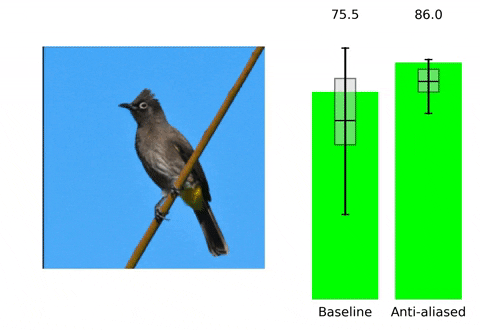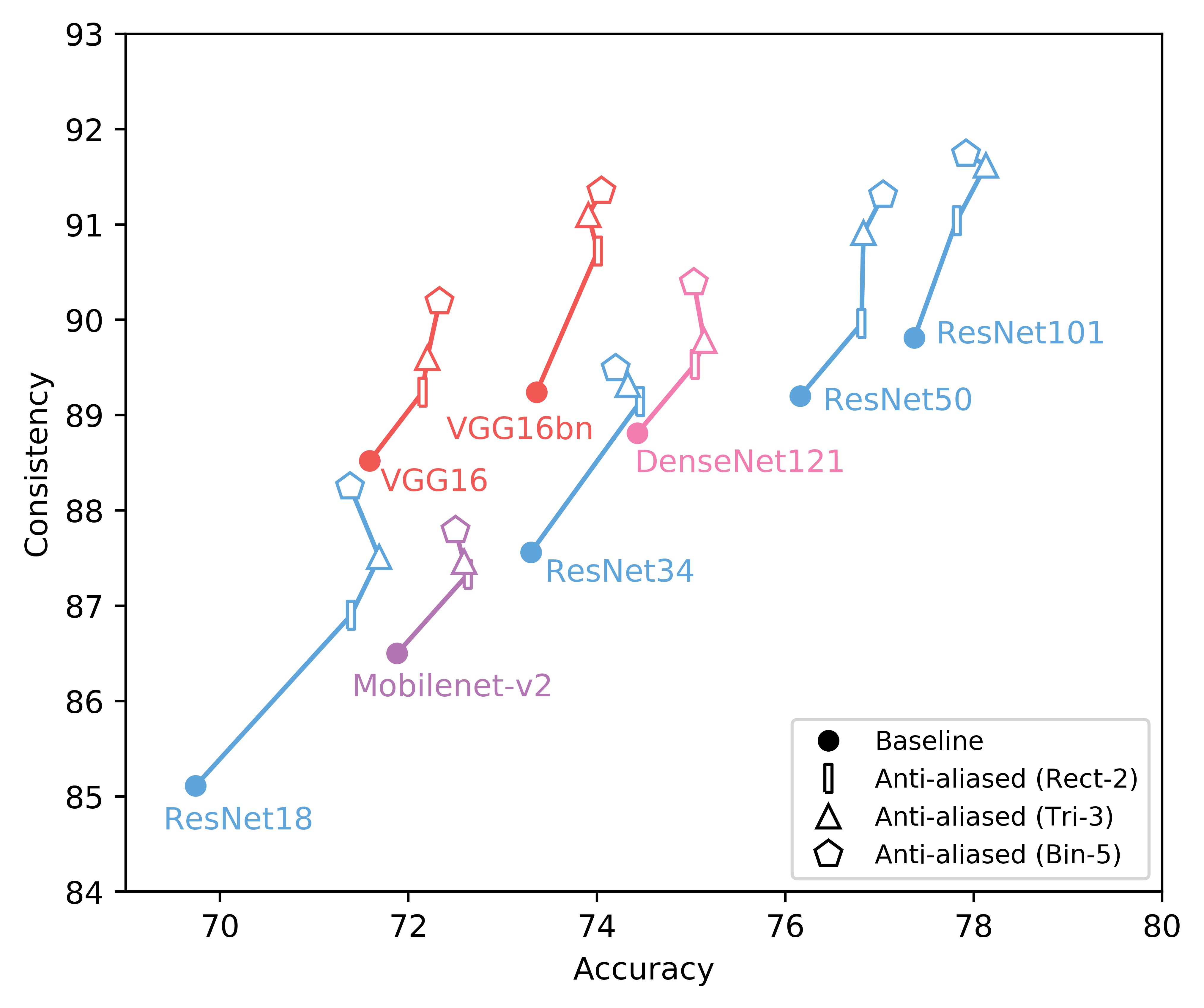Antialiased CNNs [Project Page] [Paper]
Making Convolutional Networks Shift-Invariant Again
Richard Zhang.
To appear in ICML, 2019.
This repository contains examples of anti-aliased convnets.
Table of contents
- Pretrained antialiased models
- Instructions for antialiasing your own model, using the
BlurPoollayer - Results on Imagenet consistency + accuracy.
- ImageNet training and evaluation code. Achieving better consistency, while maintaining or improving accuracy, is an open problem. Help improve the results!
This work is licensed under a Creative Commons Attribution-NonCommercial-ShareAlike 4.0 International License.
All material is made available under Creative Commons BY-NC-SA 4.0 license by Adobe Inc. You can use, redistribute, and adapt the material for non-commercial purposes, as long as you give appropriate credit by citing our paper and indicating any changes that you've made.
The repository builds off the PyTorch examples repository and torchvision models repository. These are BSD-style licensed.
- Install PyTorch (pytorch.org)
pip install -r requirements.txt
- Run
bash weights/download_antialiased_models.sh
The following loads a pretrained antialiased model, perhaps as a backbone for your application.
import torch
import models_lpf.resnet
model = models_lpf.resnet.resnet50(filter_size=3)
model.load_state_dict(torch.load('weights/resnet50_lpf3.pth.tar')['state_dict'])We also provide weights for antialiased AlexNet, VGG16(bn), Resnet18,34,50,101, Densenet121, and MobileNetv2 (see example_usage.py).
The methodology is simple -- first evaluate with stride 1, and then use our Downsample layer (also referred to as BlurPool) to do antialiased downsampling.
- Copy
models_lpfinto your codebase. This file contains theDownsampleclass, which does blur+subsampling. Put the following into your header.
from models_lpf import *- Make the following architectural changes to antialias your strided layers. Typically, blur kernel
Mis 3 or 5.
| Baseline | Anti-aliased replacement |
|---|---|
[nn.MaxPool2d(kernel_size=2, stride=2),] |
[nn.MaxPool2d(kernel_size=2, stride=1), Downsample(channels=C, filt_size=M, stride=2)] |
[nn.Conv2d(Cin,C,kernel_size=3,stride=2,padding=1), nn.ReLU(inplace=True)] |
[nn.Conv2d(Cin,C,kernel_size=3,stride=1,padding=1), nn.ReLU(inplace=True), Downsample(channels=C, filt_size=M, stride=2)] |
nn.AvgPool2d(kernel_size=2, stride=2) |
Downsample(channels=C, filt_size=M, stride=2) |
We assume incoming tensor has C channels. Computing a layer at stride 1 instead of stride 2 adds memory and run-time. As such, we typically skip antialiasing at the highest-resolution (early in the network), to prevent large increases.
We show consistency (y-axis) vs accuracy (x-axis) for various networks. Up and to the right is good. Training and testing instructions are here.
We italicize a variant if it is not on the Pareto front -- that is, it is strictly dominated in both aspects by another variant. We bold a variant if it is on the Pareto front. We bold highest values per column.
Note that the current arxiv paper is slightly out of date; we will update soon.
AlexNet (plot)
| Accuracy | Consistency | |
|---|---|---|
| Baseline | 56.55 | 78.18 |
| Rect-2 | 57.24 | 81.33 |
| Tri-3 | 56.90 | 82.15 |
| Bin-5 | 56.58 | 82.51 |
VGG16 (plot)
| Accuracy | Consistency | |
|---|---|---|
| Baseline | 71.59 | 88.52 |
| Rect-2 | 72.15 | 89.24 |
| Tri-3 | 72.20 | 89.60 |
| Bin-5 | 72.33 | 90.19 |
VGG16bn (plot)
| Accuracy | Consistency | |
|---|---|---|
| Baseline | 73.36 | 89.24 |
| Rect-2 | 74.01 | 90.72 |
| Tri-3 | 73.91 | 91.10 |
| Bin-5 | 74.05 | 91.35 |
ResNet18 (plot)
| Accuracy | Consistency | |
|---|---|---|
| Baseline | 69.74 | 85.11 |
| Rect-2 | 71.39 | 86.90 |
| Tri-3 | 71.69 | 87.51 |
| Bin-5 | 71.38 | 88.25 |
ResNet34 (plot)
| Accuracy | Consistency | |
|---|---|---|
| Baseline | 73.30 | 87.56 |
| Rect-2 | 74.46 | 89.14 |
| Tri-3 | 74.33 | 89.32 |
| Bin-5 | 74.20 | 89.49 |
ResNet50 (plot)
| Accuracy | Consistency | |
|---|---|---|
| Baseline | 76.16 | 89.20 |
| Rect-2 | 76.81 | 89.96 |
| Tri-3 | 76.83 | 90.91 |
| Bin-5 | 77.04 | 91.31 |
ResNet101 (plot)
| Accuracy | Consistency | |
|---|---|---|
| Baseline | 77.37 | 89.81 |
| Rect-2 | 77.82 | 91.04 |
| Tri-3 | 78.13 | 91.62 |
| Bin-5 | 77.92 | 91.74 |
DenseNet121 (plot)
| Accuracy | Consistency | |
|---|---|---|
| Baseline | 74.43 | 88.81 |
| Rect-2 | 75.04 | 89.53 |
| Tri-3 | 75.14 | 89.78 |
| Bin-5 | 75.03 | 90.39 |
MobileNet-v2 (plot)
| Accuracy | Consistency | |
|---|---|---|
| Baseline | 71.88 | 86.50 |
| Rect-2 | 72.63 | 87.33 |
| Tri-3 | 72.59 | 87.46 |
| Bin-5 | 72.50 | 87.79 |
This repository is built off the PyTorch ImageNet training and torchvision models repositories.
If you find this useful for your research, please consider citing this bibtex. Please contact Richard Zhang <rizhang at adobe dot com> with any comments or feedback.




